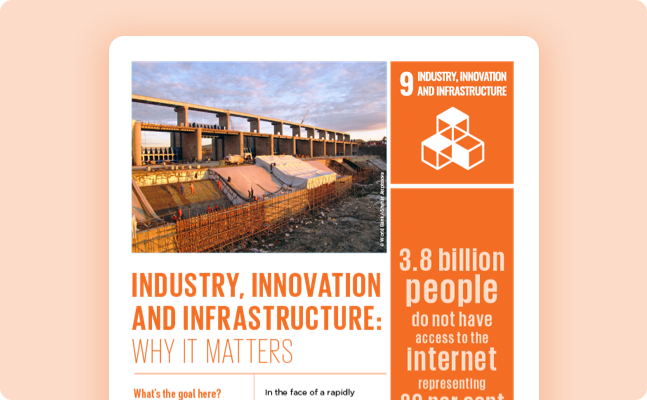special thnaks to all of asia which seems to value infrastructure next generation needs - here is a un post received august 7 , 2023
Goal 9 seeks to build resilient infrastructure, promote sustainable industrialization and foster innovation. Economies with a diversified industrial sector and strong infrastructure sustained less damage and are experiencing faster recovery. In 2021, global manufacturing rebounded from the pandemic, although the recovery remains incomplete and uneven.
Higher-technology industries performed better and recovered faster, providing a strong example of how important technological innovation is to achieving Goal 9.
- Global manufacturing production grew by 7.2 per cent in 2021, surpassing its pre-pandemic level.
- The global share of manufacturing value added in total GDP increased from 16.2 per cent in 2015 to 16.9 per cent in 2021.
- Globally, the share of manufacturing jobs in total employment declined from 13.7 per cent in 2019 to 13.1 per cent in 2020.
- The number of airline passengers travelling internationally totalled 2.3 billion in 2021, sharply falling from 4.5 billion in 2019 and resulting in financial losses of $324 billion.
- In 2021, domestic air traffic reached 68 per cent of 2019 levels, while international traffic remained weak – at 28 per cent – mostly due to sporadic outbreaks of COVID-19 variants and travel restrictions.
- Driven by a resurgence of economic activity along with a roaring e-commerce industry during the pandemic, air cargo traffic exceeded pre-pandemic levels by the beginning of 2021 and is maintaining robust growth.
- Only about one in three small manufacturers are benefiting from a loan or line of credit.
- 15.7 per cent of small-scale industries in Africa and 44.2 per cent in Latin America and the Caribbean received the forms of credit.
- In 2019, the share of medium- and high-tech manufacturing in total manufacturing in Europe and Northern America was 47.7 per cent compared with 21.4 per cent in sub-Saharan Africa and 10.5 per cent in least developed countries.
- Between 2015 and 2021, 4G network coverage doubled, reaching 88 per cent of the world’s population.
- Although 2021 estimates show that 95 per cent of the world’s population are covered by a mobile-broadband network, the gap remains significant for least developed countries and landlocked developing countries, where 17 per cent of the population are without coverage.
- In least developed countries, 14 per cent of the rural population have no mobile network coverage at all, while another 12 per cent have only 2G coverage.
COVID-19 response
 Information and communication technologies have been on the frontlines of the COVID-19 response. The crisis has accelerated the digitalization of many businesses and services, including teleworking and video conferencing systems in and out of the workplace, as well as access to healthcare, education and essential goods and services.
Information and communication technologies have been on the frontlines of the COVID-19 response. The crisis has accelerated the digitalization of many businesses and services, including teleworking and video conferencing systems in and out of the workplace, as well as access to healthcare, education and essential goods and services.
As the pandemic reshapes the way in which we work, keep in touch, go to school and shop for essentials, it has never been more important to bridge the digital divide for the 3.6 billion people who remain offline, unable to access online education, employment or critical health and sanitation advice. The 2020 Financing for Sustainable Development Report provides policy options to harness the potential of digital technologies.
Once the acute phase of the COVID-19 crisis is over, governments will need investments in infrastructure more than ever to accelerate economic recovery, create jobs, reduce poverty, and stimulate productive investment.
The World Bank estimates that developing countries need to invest around 4.5 per cent of GDP to achieve the Sustainable Development Goals and at the same time limit global warming to no more than 2 degrees Celsius.



No comments:
Post a Comment